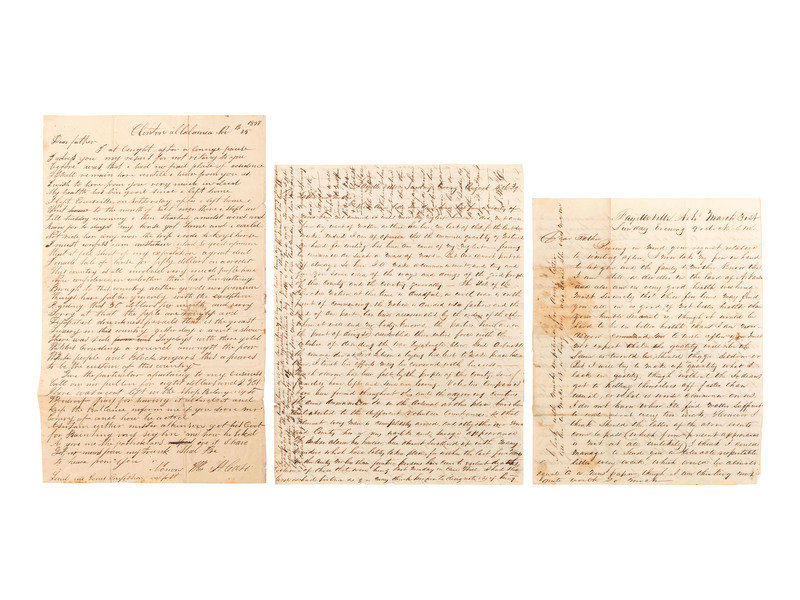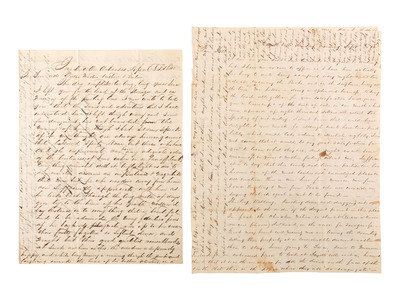Condition Report
Contact Information
Auction Specialist
Lot 347
[WESTERN AMERICANA - NATIVE AMERICANS]. A group of 8 letters written by Stuart W. Case (1819-1879), most from Fayetteville, Arkansas, describing the Cherokee and forced emigration on the "Trail of Tears." Ca 1838-1840.
Sale 1250 - American Historical Ephemera & Photography
Nov 30, 2023
10:00AM ET
Live / Cincinnati
Own a similar item?
Estimate
$1,000 -
2,000
Price Realized
$8,820
Sold prices are inclusive of Buyer’s Premium
Lot Description
[WESTERN AMERICANA - NATIVE AMERICANS]. A group of 8 letters written by Stuart W. Case (1819-1879), most from Fayetteville, Arkansas, describing the Cherokee and forced emigration on the "Trail of Tears." Ca 1838-1840.
8 stampless covers, spanning July 1838 - April 1840, most on 8 x 10 in. lettersheets, together totaling more than 21pp of correspondence (expected wear given age, two letters with larger losses affecting text, some with adhesive repair, all legible). Each letter addressed to Mr. Thomas Case in New Albany, Indiana, from his son Stuart W. Case, with all but two sent from Fayetteville, Arkansas, a conversion point for several removal routes across the state. Letters offer a fascinating eyewitness account of Indian Removal, the businesses that arose to supply the forced emigrants along their route, and of the intratribal animosity between followers of Cherokee leaders John Ross and Major Ridge which culminated in the assassination of Ridge.
Stuart Walter Case ("Cayce" in some sources) was born in New Albany, Indiana, to Thomas Case (1790-1840) and Jane Simonton Case (1791-1850). Just shy of his twentieth birthday he departed Indiana for Arkansas in anticipation of working as a store clerk for "Mr. Wilson," seemingly a family acquaintance who had settled in Oakland, Arkansas. The earliest letter in the grouping dated 6 July 1838 indicates that Mr. Wilson purchased a small farm near the boundary line between Neosho [Indian] Territory and the Arkansas state line, "a point of considerable importance, being just where the 'military Road' that leads to Fort Gibson leaves the state line...there is an immense amount of travel on it, waggons passing constantly going down in the nations among the Indians to trade, loaded generally with meal bacon & flour and most other kinds of provisions all these articles are worth about one hundred pr ct more in the nation than they are here." Later in the letter Case describes the diversity of customers who frequent Mr. Wilson's establishment: "our customers being a great many of them Indians or mix'd blood...some of them being very fine people...a white man with a black wife is an occurrence not at all uncommon here, & vice versa." Case then elaborates on the fear among the locals about the Creek Indians, who have mingled with the Seminole, and the possibility of a war with them.
In his next letter of 11 October 1838, Case has removed to Fayetteville and started a new position working as a clerk for Mr. James Sutton. Case indicates that the situation is preferable due to the quality of the customers frequenting the grocery, and the "pretensions of society" that are developing in Fayetteville. In his letter of 4 December 1838, he mentions the building of forts to defend the frontier, ending his letter saying that "Great preparations are also making for the emigrating Cherokees who are daily expected, agents are riding all about the country, buying up provisions, corn &c for their sustenance, stands are being erected every ten miles all through Missouri & Arkansas as depots for corn it's said that 1200 are within a few days march of here now, the whole number to come is computed at 14 to 15 thousand souls...."
Four months later, Case observes that the "stir and bustle of the Cherokee emigration is beginning to die away, most of them having already arrived and taken up their abode in the far west to all appearances well satisfied...the agents are busily engaged in dispensing of the waggons & horses which were used in bringing them out...." He then continues, describing the political tensions which have ripped the Cherokee Nation into two factions, the "Ross party" and the "Ridge party." "These rival factions cannot bear the sight of each other, and if they happen to meet any where there is always sure to be a fight...." Tensions between the Cherokee are again described in a lengthy letter of 4 August 1839. Written approximately one month after Major Ridge was assassinated by members of the Ross faction, Case's letter paints a picture of a fractured Cherokee Nation and a surrounding community in fear: "The state of the Cherokee Nation at this time is dreadful, a civil war is on the point of commencing, the nation is divided into factions and the head of one part has been assassinated by the orders of the other where it will end no body knows...Genl. Arbuckle the commander at Fort Gibson is trying his best to make peace between them....Much alarm has been felt by the people of this county, some families have left and some are leaving...."
On 30 September 1839 Case elaborates on Cherokee tensions, mentioning that two of Ross's "most distinguished braves" were found dead in the woods near his encampment "each with a single bullet in him, done tis thought by Ridges men."
Beyond descriptions of the Cherokee, Case's letters paint a portrait of a changing and bustling Arkansas frontier, with a racially and culturally diverse group of inhabitants. Colorful description of hangings and lawlessness in Fayetteville is particularly noteworthy as well: "Suffice it to say this county and town in particular has become one of the most lawless and uncivilized places in all creation. There is men here from Mexico, men from Iowa Territory, & men from Texas, who all coincide in saying that its equal is not to be found. Shooting, stabbing, knocking down and draggint out, appear to be the order of the day at present in this place...."
The "Trail of Tears" was in fact a web of routes and rivers by which tribal groups from Alabama, Florida, Georgia, Mississippi, North Carolina, and Tennessee journeyed from their ancestral homes to Indian Territory in present-day Oklahoma. All of these trails passed through Arkansas. As the letters offered here demonstrate, the devastation of the Indians was a boom for enterprising, and sometimes greedy, business owners, while for the Cherokee the price of removal also included devastating tribal divisions. A scarce and illustrative firsthand account of Indian Removal.
Property from the James Milgram, M.D., Collection of Broadsides, Ephemeral Americana, and Historical Documents





